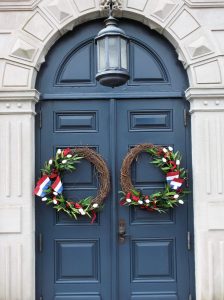Dutch-American Friendship Day

Discover Delaware’s Dutch roots and learn how that connection is still alive today during Dutch-American Friendship Day from 10 a.m. to 4:15 p.m. on Saturday, April 16, at the Zwaanendael Museum in Lewes. Dedicated by President Ronald Reagan on April 19, 1982, this year marks the 40th annual Dutch-American Friendship Day.
In 1631, the Dutch sailing ship “The Walvis” arrived at what is now Lewes and established the town of Zwaanendael, now known as The First Town in the First State. But Native Americans had already been living on the land for generations, despite the Europeans’ claim to ownership. The following year, this settlement was destroyed by the area’s original inhabitants, which was enough to scare off the Dutch.
Although the colony lasted barely a year, the claiming of the territory fostered Dutch resettlement of the lower Delaware Valley. In 1655, after about 24 years, they would intensify settlement efforts. The South River, including the Lewes area, became a flourishing Dutch colonial area. The settlement at Lewes also included a Mennonite colony under Pieter Cornelisen Plockhoy by 1663. Other Dutch colonies were successful, including those in northern New York state, in the Caribbean and as far south as Brazil and Chile.
Although Lewes residents are familiar with the Dutch connection, other European influences are more prevalent in the country’s colonial history. During the fight for independence, the Dutch were seen as the first formal supporters and played a role in supplying arms, ammunition and other goods to the American rebels in exchange for indigo from the Carolinas and tobacco from the Chesapeake region.
Although the Netherlands and Britain shared a military alliance, officials and citizens were sympathetic to the American cause. One Dutch government official vigorously opposed the king’s request in 1775 for military support and his speech sparked resistance across the nation.



Merchants and officials in Amsterdam were unwavering in their support of Americans and were in favor of a treaty for trade and commerce. In 1776, on the Dutch Caribbean colony of Sint Eustatius, the Dutch governor offered an important act of solidarity as the American ship “Andrew Doria” entered the port flying the stars and stripes. An exchange of friendly fire would be dubbed the First Salute and was seen as the first formal recognition of the United States of America.
As early as 1778, the Netherlands covertly pursued commercial trade with the United States. A secret treaty was devised between representatives in Amsterdam and the U.S. The American ship transporting the agreement was captured by the British in 1780. The treaty showed increasing pro-American sentiment in the Netherlands and provoked England. A few weeks later, King George III declared war on their former ally. The American Revolution was a shared conflict with Dutch allies against a common enemy.
About a decade after the U.S. prevailed against the British, the Dutch succeeded in overthrowing British rulers. Dutch-American Friendship Day is a long-standing celebration of support for freedom and independence. Lewes also celebrates the historical connection in conjunction with its annual Lewes Tulip Celebration. Learn more facts and trivia about the Dutch and enjoy traditional activities and games during this free, annual event held at a distinctly Dutch building that recognizes Lewes’ colonial origins. For more information, go to history.delaware.gov/events/dutch-american-friendship-day, call 302-645-1148 or email zmuseum@delaware.gov.


